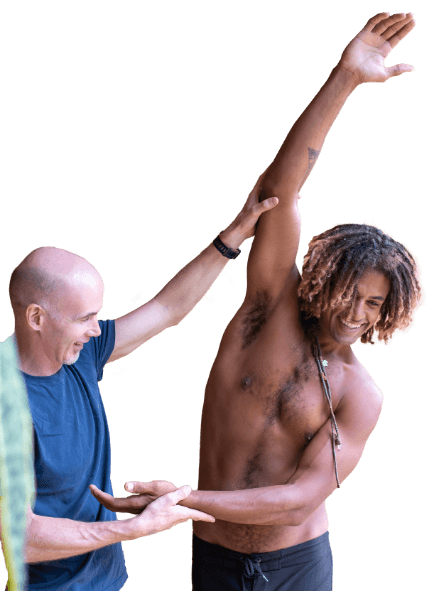
Chronic back pain is a pervasive issue affecting millions worldwide, particularly among middle-aged adults. It can be debilitating, affecting daily activities, work productivity, and overall quality of life. Understanding the root causes of chronic back pain and exploring a multidisciplinary approach to treatment can offer significant relief and improve well-being.
Chronic back pain can be complex, with multiple factors contributing to its development, but it usually starts with a mild injury. This could be a strain on a muscle or a ligament, or it could come from the disc bulging and pushing on nerves. Ordinarily, an initial injury would improve in the typical tissue healing time frames, but chronic pain, commonly described as pain lasting longer than 3 months, doesn’t just go away.
Pain Science studies the interactions between our body, our mental state, and our environment to help us better understand why a person who should get better sometimes ends up with chronic pain.
For many therapists and patients, pain is often seen as a mechanical issue: something is pinching, so it needs to be moved to alleviate the pain. This is why a surgeon might operate on a herniated disc to remove the part pressing on a nerve, aiming to relieve the pain. However, this model doesn’t always produce the desired results. For example, it is common to see herniated discs in people who do not have pain (1), and there are well-documented cases of phantom limb pain where the person experiences pain in an area that isn’t even there.
Conversely, there are people who have debilitating pain with no visible structural cause seen on MRIs. So, we can’t say that the ‘mechanical model of injury = pain’ is reliable.
Thanks to the research of experts like Gordon Waddell, a spine surgeon who screened patients before surgery for factors that might impede their recovery, we now understand that issues such as lawsuits for compensation, depression, and severe pain without tissue injury can all contribute to chronic pain (2). But why is this? What is happening in the body to cause this, and what can we do about it?
I really like reading the work of the physiotherapist Louis Gifford. He spent most of his career thinking about chronic pain and how to treat it better. He used models to help explain some of these complex topics, and one of the models he referred to was the Mature Organism Model or MOM. In this model, the brain is seen as a ‘scrutinizing’ organism that constantly analyzes information from the body, external environment, and memories. It uses information from these 3 areas and overlays them on our innate evolutionary reflexes to make some decisions.
A person is running in a race, takes a misstep, and sprains their ankle. The brain processes the pain information from the ankle and compares it to past experiences. This individual has had a mild sprain before that healed quickly, and the current pain feels similar. Assessing the environment, the brain notes that it’s only a few kilometers to the finish line, and overcoming the sprain will make for a good story. The person gets up, finishes the race, and feels proud. The next day, the ankle is swollen, but they continue their daily routine, which helps reduce inflammation and keeps the muscles strong. Within a few days, they forget about the injury. The combination of information from the injury, past experiences, and the current environment contributes to a swift recovery.
Consider Dave’s situation: he has just slipped at work and is now lying on the warehouse floor, experiencing excruciating back pain that immobilizes him. His brain is processing the pain signals from his back, trying to interpret them, especially since he has never previously injured his back. Recalling his uncle’s experience of a work-related slip resulting in long-term disability benefits, Dave begins to fear he has sustained severe damage. The warehouse supervisor notices Dave’s distress but lacks experience with back pain, unaware that back injuries often cause more intense pain than injuries to other parts of the body and that pain severity doesn’t always correlate directly with the extent of injury. Dave is advised to remain still “just in case it’s serious,” and emergency services are summoned.
As time passes, Dave’s muscles begin to stiffen, worsening his pain. Eventually, he is taken to the hospital, where he receives a clean bill of health and is instructed to rest. However, due to the severity of his pain, Dave remains convinced that something has been overlooked. Luckily, his wife and kids rally around him, and he doesn’t have to lift a finger in the house. However, we might be able to see trouble ahead for Dave for the following reasons:
Can you see how this is setting Dave up for chronic pain?
What is the best way to help Dave?
Treating chronic back pain often requires a comprehensive, multidisciplinary approach. This could be delivered by a team of healthcare experts, or many of these components could be delivered by a well-trained therapist.
Chronic back pain can significantly impact your life, but understanding its causes and exploring a multidisciplinary approach to treatment can make a substantial difference. By combining physical therapy, medical management, cognitive behavioral therapy, alternative therapies, and lifestyle modifications, you can effectively manage and alleviate chronic back pain. If you want to discuss your specific situation with me, please contact me via the Contact Us page. We’ll see if we can make ‘your lifestyle your medicine.’
References:

Over the last 10 years Ed has been building a YouTube library to help people manage their own pain or movement limitations and increase performance through exercise. He regularly adds videos so be sure to subscribe and visit regularly


"Oh My Gosh- I am ALREADY feeling relief after a few days! I used to wake up 2-3 times a night with shooting pain that anti inflammatories couldn't touch. Now I have been waking up just because I want to notice what it feels like to lay in bed pain free- THANK YOU!."

"When I first started with your program I was experience a lot of pain. Walking was difficult. I had to stop and catch my breath every few minutes and lean against a wall for support. Now when I walk with my husband we go for over an hour. I never had to sit down and stop...and, hardly any pain!!! 😊😊 I can’t thank you enough."
Frustrated that you aren't recovering fast enough?
Discover how to heal from illness and injury using movement, food and lifestyle.